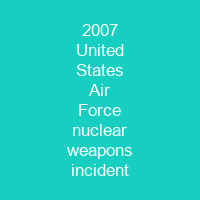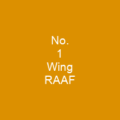What Went Wrong at Minot Air Force Base?
On August 29, 2007, a series of events unfolded that would shake the foundations of nuclear security within the United States Air Force (USAF). Six AGM-129 ACM cruise missiles loaded with W80-1 variable yield nuclear warheads were mistakenly loaded onto a B-52H bomber at Minot Air Force Base in North Dakota. These weapons, meant to be stored securely, remained mounted on the aircraft for 36 hours without proper security precautions. This incident was not just a simple mistake; it was a breach of trust and responsibility that reverberated through military ranks.
The Fallout from the Mishap
When the transport crew failed to verify that the missiles had been inspected or cleared for removal, and the aircraft remained parked overnight without a special guard, the stage was set for disaster. A subsequent inspection revealed that some of these missiles contained nuclear warheads, which were discovered 36 hours after they were removed from their bunker. The incident was reported as ‘one of the worst breaches in US nuclear weapons security in decades.’ It was a stark reminder of how fragile and critical nuclear safety protocols are.
Disciplinary Actions and Changes
The repercussions were swift and severe. Sixty-five airmen lost their Personnel Reliability Program certifications, tactical ferry operations were suspended, and inspections were ordered at all nuclear-capable units. The incident led to a court-martial convening authority being convened, but no charges were filed. A Defense Science Board advisory panel was formed to study the mishap and review procedures for handling nuclear weapons. A ‘blue ribbon’ review chaired by Major General Polly Peyer made recommendations on improving the Air Force’s capability to safely handle nuclear weapons.
USAF Actions
The 5th Bomb Wing, responsible for the incident, was recertified after failing initial inspections. A new policy directive regarding the handling of nuclear weapons and delivery systems was issued. Personnel from Barksdale’s 2nd Bomb Wing temporarily took over maintenance duties for Minot’s nuclear stockpile. These actions underscored the seriousness with which the USAF approached rectifying the situation.
Review Reports and Recommendations
Review reports concluded that more resources and attention were needed to properly inspect and handle nuclear weapons. The combining of DoD nuclear forces with nonnuclear organizations had led to a devaluation of the nuclear mission and its performers. No failures in the security of United States nuclear weapons were found, but the incident highlighted critical areas for improvement.
Long-Term Impacts
The 5th Bomb Wing passed a nuclear security inspection in nine out of ten areas but failed the area of training and discipline, prompting security forces commanders to be replaced. An investigation into an incorrect shipment to Taiwan found issues with Air Force nuclear mission focus, technical competence, and stewardship. Robert Gates announced disciplinary measures for general officers and colonels involved in declining nuclear performance.
Structural Changes
A senior-level task force recommended placing all nuclear weapons under a single command called Air Force Strategic Command, replacing the current Air Force Space Command. The task force also suggested moving 1,500 to 2,000 airmen into nuclear-related jobs. On September 25, 2008, the US Department of Defense announced disciplinary actions against six Air Force generals and nine colonels due to inadequate nuclear oversight following a mistaken shipment of nuclear fuzes to Taiwan.
Key Individuals Affected
Lt. Gen. Kevin J. Sullivan (demoted and retired), Lt. Gen. Michael A. Hamel (letter of admonishment, allowed to retire), Maj. Gen. Roger W. Burg (letter of admonishment, allowed to remain in position), Maj. Gen. Kathleen D. Close (letter of admonishment, allowed to stay on), Brig. Gen. Francis M. Bruno (letter of admonishment, allowed to retire) and Brig. Gen. Arthur B. Cameron III, commander of the 309th Maintenance Wing, received a letter of admonishment and were reassigned. The Army generals involved also faced disciplinary actions.
Conclusion
The Minot Air Force Base nuclear weapons incident was more than just a series of unfortunate events; it was a wake-up call for the entire military establishment. It highlighted the critical importance of rigorous adherence to protocols and the potential catastrophic consequences when these are neglected. As we reflect on this event, one thing is clear: the safety and security of our nation’s nuclear arsenal must remain a top priority.

You want to know more about 2007 United States Air Force nuclear weapons incident?
This page is based on the article 2007 United States Air Force nuclear weapons incident published in Wikipedia (retrieved on November 28, 2024) and was automatically summarized using artificial intelligence.







